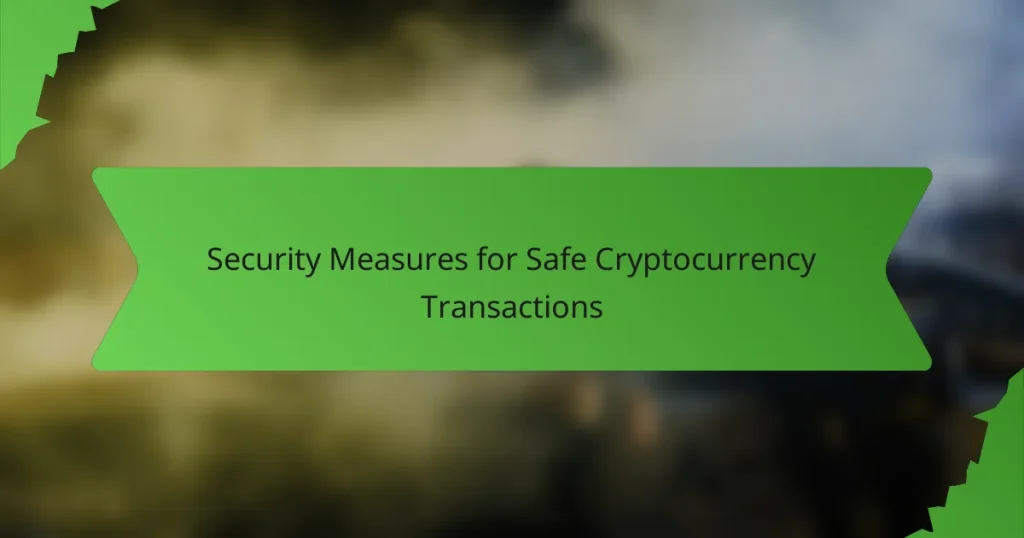The article focuses on security measures for safe cryptocurrency transactions, emphasizing the importance of strong passwords and two-factor authentication to prevent unauthorized access. It discusses the benefits of using hardware wallets for secure storage, as well as the need for regular software updates to address vulnerabilities. The article highlights various security techniques employed by cryptocurrency platforms, including cold storage, encryption protocols, and multi-signature wallets, to enhance protection against theft and fraud. Additionally, it explores emerging trends such as multi-factor authentication, decentralized identity solutions, and AI-driven threat detection, which aim to bolster user-centric security frameworks in the cryptocurrency space.

What are Security Measures for Safe Cryptocurrency Transactions?
Security measures for safe cryptocurrency transactions include using strong passwords and two-factor authentication. Strong passwords should be complex and unique to prevent unauthorized access. Two-factor authentication adds an extra layer of security by requiring a second form of verification.
Additionally, users should store their cryptocurrencies in hardware wallets instead of online exchanges. Hardware wallets are less vulnerable to hacking and provide greater control over funds. Regularly updating software and wallets is essential to protect against vulnerabilities.
Educating oneself about phishing scams can help avoid fraudulent schemes. Users should only engage with reputable platforms and verify URLs before entering sensitive information. According to a report by Chainalysis, over $3.2 billion was lost to cryptocurrency theft in 2020, highlighting the importance of these security measures.
Why are security measures essential for cryptocurrency transactions?
Security measures are essential for cryptocurrency transactions to protect against fraud and theft. Cryptocurrencies operate on decentralized networks, making them vulnerable to hacking. In 2021, cryptocurrency thefts exceeded $14 billion, highlighting the need for robust security. Security measures include encryption, multi-factor authentication, and secure wallets. These measures help ensure the integrity and confidentiality of transactions. Without them, users risk losing their funds and personal information. Therefore, implementing security measures is crucial for maintaining trust in cryptocurrency systems.
What risks are associated with cryptocurrency transactions?
Cryptocurrency transactions carry several risks. These include volatility, which can lead to significant financial loss. Security risks are prevalent, such as hacking and phishing attacks. Users may also face regulatory risks due to changing laws. Transaction irreversibility poses a challenge, as mistakes cannot be easily corrected. Additionally, there is a risk of fraud, with scams targeting inexperienced users. Lack of consumer protection can leave individuals vulnerable to losses. According to a 2021 report by Chainalysis, over $7.7 billion was lost to cryptocurrency scams in 2021 alone.
How do security measures mitigate these risks?
Security measures mitigate risks in cryptocurrency transactions by implementing various protective strategies. These measures include encryption, which secures transaction data against unauthorized access. Multi-factor authentication adds an extra layer of security, ensuring that only authorized users can initiate transactions. Regular software updates patch vulnerabilities, reducing the risk of exploitation by hackers. Additionally, using secure wallets protects assets from theft and loss. Monitoring transactions for suspicious activity allows for quick responses to potential fraud. According to a report by the Blockchain Security Alliance, 80% of breaches occur due to weak security practices, highlighting the importance of robust security measures.
What types of security measures are commonly used?
Commonly used security measures include encryption, multi-factor authentication, and cold storage. Encryption secures data by converting it into a coded format. Multi-factor authentication requires multiple forms of verification, enhancing access security. Cold storage involves keeping cryptocurrencies offline, reducing the risk of online hacks. Additionally, regular software updates protect against vulnerabilities. These measures collectively safeguard cryptocurrency transactions from unauthorized access and theft.
What is two-factor authentication and how does it work?
Two-factor authentication (2FA) is a security process that requires two forms of identification before granting access. It enhances security by combining something the user knows, like a password, with something the user has, such as a mobile device. When a user attempts to log in, they enter their password. Then, they receive a verification code on their mobile device. The user must enter this code to complete the login process. This method significantly reduces the risk of unauthorized access. According to a study by Google, 2FA can block 100% of automated bots and 99% of targeted attacks.
How do hardware wallets enhance transaction security?
Hardware wallets enhance transaction security by storing private keys offline. This offline storage protects keys from online threats such as malware and hacking attempts. Unlike software wallets, hardware wallets require physical access to perform transactions. Users must confirm transactions on the device itself, adding an extra layer of security. Most hardware wallets use secure elements to safeguard sensitive data. These secure elements are designed to resist tampering and unauthorized access. According to a report by Ledger, hardware wallets can significantly reduce the risk of theft compared to online wallets. Thus, hardware wallets provide a robust solution for secure cryptocurrency transactions.
What best practices should users follow to ensure security?
Users should follow several best practices to ensure security in cryptocurrency transactions. First, they must use strong, unique passwords for their accounts. Passwords should contain a mix of letters, numbers, and symbols. Second, enabling two-factor authentication adds an extra layer of protection. This requires a second form of verification beyond just the password. Third, users should regularly update their software and wallets. Updates often include important security patches. Fourth, they must be cautious with public Wi-Fi networks. Using a secure, private connection is advisable for transactions. Fifth, users should only use reputable exchanges and wallets. Researching the exchange’s security history can provide insight into its reliability. Lastly, users should back up their wallet information securely. This ensures access to funds in case of device loss or failure. Following these practices significantly reduces the risk of unauthorized access and potential loss of funds.
How can users create strong passwords for their accounts?
Users can create strong passwords for their accounts by combining uppercase letters, lowercase letters, numbers, and special characters. A strong password should be at least 12 characters long. Avoid using easily guessable information like names or birthdays. Instead, consider using a passphrase made up of random words. Password managers can help generate and store complex passwords securely. According to the National Institute of Standards and Technology (NIST), using unique passwords for different accounts significantly reduces security risks. Regularly updating passwords also enhances account protection.
What role does regular software updating play in security?
Regular software updating is crucial for maintaining security. It protects systems from vulnerabilities by applying patches and fixes. Cyber threats evolve constantly, and software updates address newly discovered security flaws. For instance, the 2017 Equifax breach occurred due to unpatched software vulnerabilities. Regular updates also enhance system performance and functionality. According to a report by Cybersecurity Ventures, 60% of data breaches are linked to unpatched vulnerabilities. Thus, consistent software updates are essential for safeguarding against potential security risks.

How do different cryptocurrency platforms implement security measures?
Different cryptocurrency platforms implement security measures through various techniques. These include two-factor authentication, cold storage, and encryption protocols. Two-factor authentication adds an extra layer of security by requiring a second form of verification. Cold storage keeps the majority of funds offline, reducing the risk of hacking. Encryption protocols safeguard user data during transactions. Regular security audits and compliance with regulations also enhance platform security. Multi-signature wallets require multiple approvals for transactions, adding another layer of protection. These measures collectively help mitigate risks associated with cryptocurrency transactions.
What security features are offered by popular cryptocurrency exchanges?
Popular cryptocurrency exchanges offer several security features to protect user assets. These features include two-factor authentication (2FA), which adds an extra layer of security by requiring a second form of verification. Many exchanges utilize cold storage for the majority of their funds, keeping them offline to prevent hacking.
Additionally, some platforms implement withdrawal whitelist options, allowing users to specify addresses for withdrawals. This prevents unauthorized withdrawals to unknown addresses. Regular security audits and compliance with regulations also enhance trust and safety.
Encryption protocols are standard for protecting user data during transactions. Furthermore, some exchanges provide insurance coverage for digital assets in case of breaches. These features collectively aim to safeguard user investments and enhance overall security.
How does user verification work on these platforms?
User verification on cryptocurrency platforms typically involves multiple steps to ensure security. First, users must create an account and provide personal information. This often includes name, email address, and phone number.
Next, platforms commonly require identity verification. Users may need to upload government-issued identification, such as a passport or driver’s license. Some platforms also request a selfie for [censured] recognition.
After submitting documents, the platform reviews the information. This process can take from a few minutes to several days, depending on the platform’s policies.
Once verified, users receive confirmation via email or notification. This verification helps prevent fraud and ensures compliance with regulations.
Research shows that platforms with robust verification processes significantly reduce the risk of unauthorized access and fraudulent activities.
What is the importance of withdrawal whitelists?
Withdrawal whitelists are crucial for enhancing security in cryptocurrency transactions. They restrict withdrawals to pre-approved addresses. This minimizes the risk of unauthorized access and theft. In the event of a security breach, attackers cannot transfer funds to unapproved addresses. Many exchanges and wallets offer this feature as a protective measure. By implementing withdrawal whitelists, users can have greater control over their assets. This practice is increasingly recommended by security experts in the cryptocurrency field.
What security protocols do decentralized platforms utilize?
Decentralized platforms utilize various security protocols to ensure safe transactions. These protocols include blockchain technology, which provides transparency and immutability. Cryptographic techniques, such as public and private key encryption, secure user identities and transaction data. Consensus mechanisms like Proof of Work and Proof of Stake validate transactions and prevent fraud. Smart contracts automate agreements and reduce the risk of human error. Additionally, decentralized identity solutions enhance user privacy and control over personal information. These measures collectively create a robust security framework for decentralized platforms.
How does smart contract auditing contribute to security?
Smart contract auditing enhances security by identifying vulnerabilities before deployment. Auditors review code for logical errors, security flaws, and compliance with standards. This process reduces the risk of exploits that could lead to financial losses. According to a report by OpenZeppelin, over 70% of smart contracts contain vulnerabilities. Regular audits can mitigate these risks significantly. By ensuring code integrity, auditing builds trust among users and stakeholders in the cryptocurrency ecosystem.
What are the benefits of decentralized finance (DeFi) security measures?
Decentralized finance (DeFi) security measures enhance user protection and asset integrity. They reduce risks associated with centralized control, minimizing single points of failure. Smart contracts automate transactions, ensuring transparency and reducing human error. Multi-signature wallets require multiple approvals for transactions, adding an extra layer of security. Regular audits identify vulnerabilities, strengthening the overall system. Insurance protocols offer compensation for losses due to hacks or failures, increasing user confidence. These measures collectively create a safer environment for financial transactions in the DeFi space.

What emerging trends in security measures should users be aware of?
Emerging trends in security measures for cryptocurrency transactions include multi-factor authentication, decentralized identity solutions, and AI-driven threat detection. Multi-factor authentication enhances security by requiring multiple verification methods, reducing unauthorized access. Decentralized identity solutions empower users with control over their personal information, minimizing data breaches. AI-driven threat detection systems analyze transaction patterns in real-time, identifying anomalies that indicate potential fraud. Additionally, biometric authentication methods, such as fingerprint or [censured] recognition, are gaining traction for secure access. These trends reflect the industry’s shift towards more robust, user-centric security frameworks.
How is artificial intelligence being used in cryptocurrency security?
Artificial intelligence is enhancing cryptocurrency security through advanced threat detection and fraud prevention. AI algorithms analyze transaction patterns to identify anomalies in real-time. This capability allows for the early detection of potential security breaches. Machine learning models adapt to evolving threats by continuously learning from new data. AI also improves user authentication processes through biometric recognition technologies. These technologies reduce the risk of unauthorized access to cryptocurrency wallets. Additionally, AI-driven systems can automate compliance checks with regulations. This ensures that transactions adhere to legal standards, further enhancing security.
What are the implications of AI-driven fraud detection?
AI-driven fraud detection enhances security in cryptocurrency transactions. It identifies suspicious patterns and anomalies in real-time. This technology reduces false positives compared to traditional methods. AI algorithms analyze vast amounts of transaction data quickly. According to a 2021 report by McKinsey, AI can improve fraud detection rates by up to 50%. Enhanced detection leads to quicker response times in mitigating fraud. Additionally, AI adapts to evolving fraud tactics, ensuring ongoing protection. Ultimately, AI-driven fraud detection fosters greater trust in cryptocurrency systems.
How can machine learning enhance transaction monitoring?
Machine learning can enhance transaction monitoring by automating the detection of suspicious activities. It analyzes large volumes of transaction data in real-time. Machine learning algorithms identify patterns indicative of fraud or money laundering. They adapt to new threats by learning from historical data. This adaptability improves the accuracy of alerts generated during monitoring. For instance, a study by the European Union Agency for Cybersecurity found that machine learning models reduced false positives by up to 50%. This efficiency allows compliance teams to focus on genuine threats. Overall, machine learning significantly strengthens the integrity of transaction monitoring systems in cryptocurrency.
What future developments can improve cryptocurrency transaction security?
Future developments that can improve cryptocurrency transaction security include advanced cryptographic techniques. These techniques may involve quantum-resistant algorithms to protect against potential quantum computing threats. Multi-signature wallets are also evolving to enhance security by requiring multiple approvals for transactions.
Decentralized identity solutions can provide secure verification of user identities without compromising privacy. Furthermore, improvements in blockchain interoperability can facilitate secure cross-chain transactions.
Artificial intelligence can be utilized to detect fraudulent activities in real-time, enhancing security measures. Additionally, regulatory frameworks are expected to evolve, establishing standards for security practices in the cryptocurrency space.
These developments aim to create a more secure environment for cryptocurrency transactions, reducing risks associated with hacks and fraud.
How might quantum computing impact current security measures?
Quantum computing may significantly undermine current security measures. Traditional encryption methods rely on the difficulty of factoring large integers or solving discrete logarithm problems. Quantum computers can solve these problems efficiently using algorithms like Shor’s algorithm. This capability threatens the security of widely used encryption standards such as RSA and ECC.
Research indicates that quantum computers could break these encryption schemes in a matter of hours or even minutes. A study by the National Institute of Standards and Technology (NIST) emphasizes the urgency of developing quantum-resistant algorithms. As quantum technology advances, the need for new cryptographic methods becomes critical to protect sensitive data and secure cryptocurrency transactions.
What innovations in cryptography are on the horizon?
Quantum-resistant algorithms are among the key innovations in cryptography on the horizon. These algorithms are designed to secure data against potential threats posed by quantum computing. Current cryptographic methods may become vulnerable as quantum computers advance. Research is ongoing to develop new encryption techniques that can withstand quantum attacks. Another innovation includes homomorphic encryption, allowing computations on encrypted data without needing to decrypt it first. This method enhances privacy and security in data processing. Additionally, advancements in blockchain technology are improving cryptographic protocols for secure transactions. These innovations aim to enhance the overall security framework for cryptocurrency transactions.
What practical tips can users implement for safer cryptocurrency transactions?
Use secure wallets for storing cryptocurrency. Hardware wallets provide offline storage, minimizing hacking risks. Enable two-factor authentication on accounts. This adds an extra layer of security during login. Regularly update software and wallets. Updates fix vulnerabilities that could be exploited by attackers. Be cautious with public Wi-Fi networks. Avoid conducting transactions over unsecured connections. Verify recipient addresses before sending funds. This prevents sending to incorrect or malicious addresses. Educate yourself about phishing scams. Recognizing fraudulent messages can protect your assets. Keep backup copies of wallet recovery phrases. This ensures access to funds if the wallet is lost.
How can users identify phishing attempts effectively?
Users can identify phishing attempts effectively by scrutinizing email addresses and URLs. Check for misspellings or unusual domain names. Phishing emails often create a sense of urgency. Look for phrases urging immediate action, such as “Verify your account now.” Users should also examine the content for poor grammar or spelling errors. Legitimate organizations maintain high standards in communication. Hovering over links reveals the actual URL destination. If it looks suspicious, do not click. Additionally, users should verify requests for sensitive information directly with the organization. This can prevent falling victim to scams. According to the Anti-Phishing Working Group, over 200,000 phishing sites were reported in a single month in 2021, highlighting the prevalence of such attempts.
What steps should be taken to secure personal devices used for transactions?
To secure personal devices used for transactions, implement strong passwords and enable two-factor authentication. Regularly update software to protect against vulnerabilities. Use reputable antivirus software to detect and remove threats. Avoid public Wi-Fi for transactions, as it increases risk. Employ a virtual private network (VPN) for secure connections. Encrypt sensitive data to safeguard information. Backup important data regularly to prevent loss. Monitor accounts for unauthorized transactions to catch issues early.
The main entity of this article is security measures for safe cryptocurrency transactions. The article outlines essential security practices such as using strong passwords, enabling two-factor authentication, and storing cryptocurrencies in hardware wallets to mitigate risks associated with fraud and theft. It discusses common risks in cryptocurrency transactions, including volatility, hacking, and phishing scams, and highlights the importance of regular software updates and user education. Additionally, the article explores emerging trends in security, such as AI-driven threat detection and decentralized identity solutions, while providing practical tips for users to enhance their transaction security.




